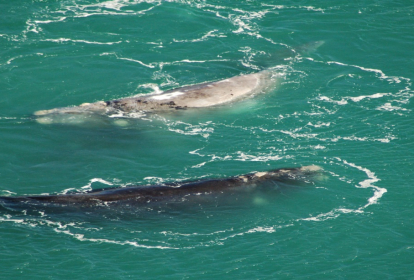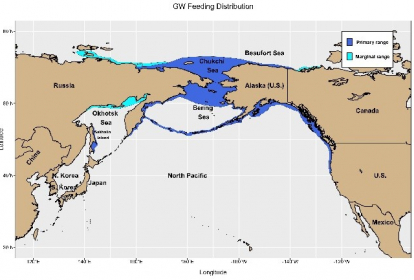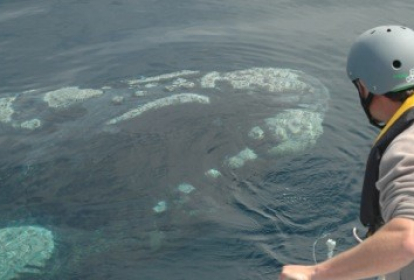The Western North Pacific population of gray whales is considered to be critically endangered, numbering only about 130 animals in 2008. Although there is evidence that it is slowly recovering, it remains on the edge of survival. Much recent attention has focused on the potential impacts associated with oil and gas developments in the population’s main feeding grounds in the Sea of Okhotsk. However the long term survival of the population depends upon co-ordinated conservation actions to address all threats.
The Conservation Management Plan for this population was developed in conjunction with the International Union for the Conservation of Nature (IUCN) and can be downloaded here. One of the first actions under the auspices of the IWC was a collaborative satellite telemetry programme that showed the movement of individuals from the western to eastern Pacific. The results from this programme have led to the need to reconsider the population structure of gray whales throughout the North Pacific and illustrate the need for CMPs to be living documents that are constantly reviewed and updated.
Southern right whales
The southern right whale was seriously depleted by whaling during the 1700s and 1800s. It was fully protected in 1935 but illegal hunting from the 1950s to 1970s delayed any recovery.
Globally this species is classified as ‘Least Concern’ by the IUCN and recently there has been an encouraging increase in several populations. The IWC’s Scientific Committee estimates that the total number of animals in 2009 was about 13,600. This figure is approaching 20% of the pre-exploitation level.
CMP for the Western South Atlantic population of Southern right whales
The population in the south-west Atlantic (which winters off Argentina and Brazil) was estimated at around 4,000 whales in 2010. Between 1971 and 2010 the population increased at an annual rate of about 6% over the entire period.
Although this long-term increase is good news, a conservation plan is needed because a number of actual and potential threats to the population’s continuing recovery have been identified. These include habitat degradation, ship strikes, entanglement and kelp gull harassment in nursery areas.
The Conservation Management Plan for this population can be downloaded here and a regional workshop was held in 2013 to begin its implementation.
CMP for the eastern South Pacific population of Southern right whales
Although the IUCN gives an overall classification for southern right whales as a species as ‘Least Concern’, the Chile-Peru subpopulation in the eastern South Pacific is classified as ‘Critically Endangered’ threatened by fishing bycatch, entanglement, ship strikes, habitat loss, pollution, climate change and acoustic disturbance. This once abundant population may number as few as around 50 individuals.
The Conservation Management Plan for this population can be downloaded here.
Future Conservation Management Plans
Humpback whales in the Arabian Sea
The IWC’s Scientific Committee has noted that humpback whales in the Arabian Sea constitute a small and isolated population that is vulnerable to human activities, and that sufficient data exist to commence a process aimed at development of a CMP. The CMP Working Group agreed with this recommendation and has encouraged key range states to begin the process.



